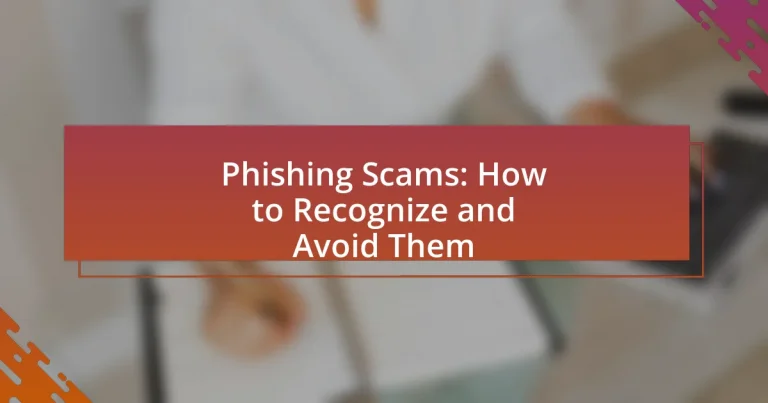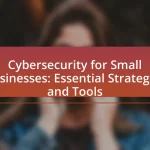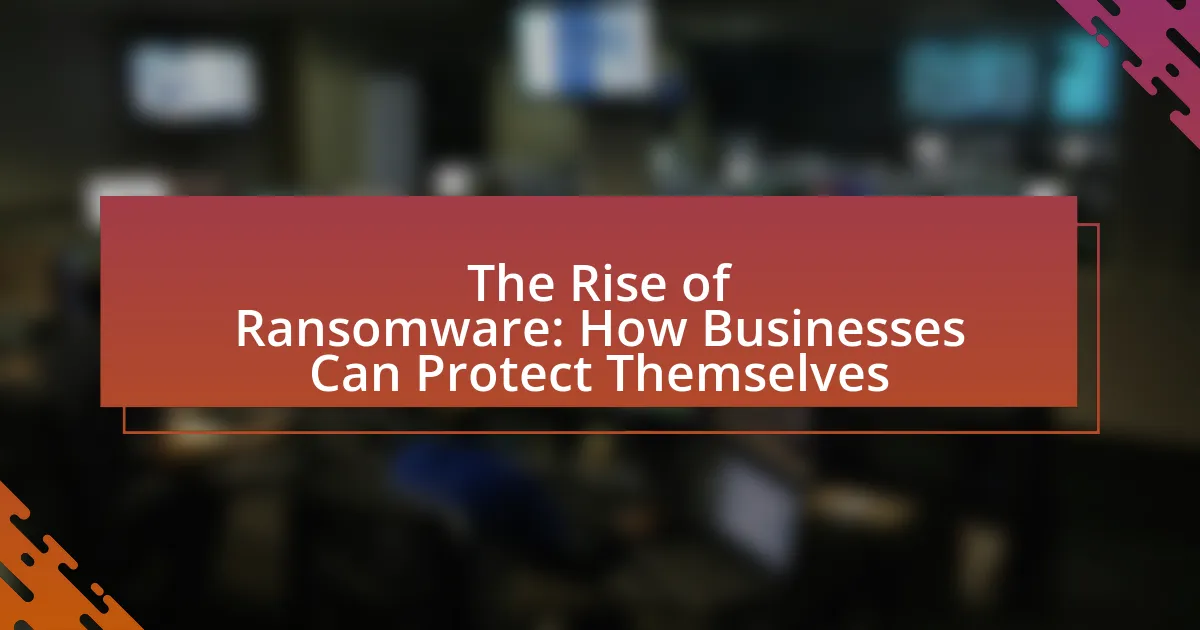Phishing scams are deceptive attempts to acquire sensitive information such as usernames, passwords, and credit card details by impersonating trustworthy entities in electronic communications. This article outlines the operation of phishing scams, the techniques employed by scammers, and the significant threats they pose to individuals and organizations. It highlights the psychological manipulation involved, the financial impacts on victims, and the importance of recognizing common signs of phishing attempts. Additionally, the article provides practical steps for individuals to protect themselves, including the use of security software, recognizing suspicious communications, and reporting phishing incidents effectively.
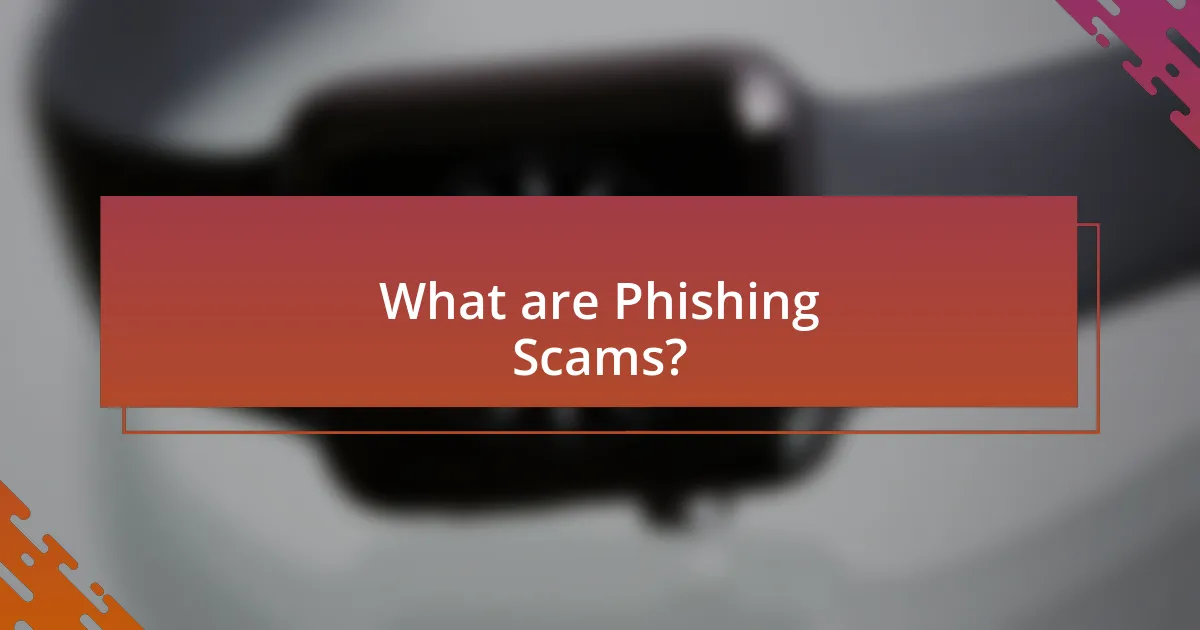
What are Phishing Scams?
Phishing scams are fraudulent attempts to obtain sensitive information, such as usernames, passwords, and credit card details, by masquerading as a trustworthy entity in electronic communications. These scams often occur through emails, messages, or websites that appear legitimate but are designed to deceive individuals into providing personal information. According to the Anti-Phishing Working Group, there were over 200,000 unique phishing sites reported in a single month in 2021, highlighting the prevalence and risk associated with these scams.
How do Phishing Scams operate?
Phishing scams operate by deceiving individuals into providing sensitive information, such as passwords or credit card numbers, through fraudulent communications. These scams typically involve emails, messages, or websites that appear legitimate but are designed to trick users into revealing personal data. For instance, a 2021 report from the Anti-Phishing Working Group indicated that phishing attacks increased by 22% compared to the previous year, highlighting the prevalence and effectiveness of these tactics.
What techniques do scammers use in Phishing?
Scammers use various techniques in phishing, including email spoofing, where they impersonate legitimate organizations to deceive victims. This method often involves creating fake email addresses that closely resemble real ones, making it difficult for recipients to identify the scam. Another common technique is the use of malicious links that direct users to counterfeit websites designed to steal personal information. Additionally, scammers may employ social engineering tactics, such as urgency or fear, to manipulate victims into providing sensitive data quickly. According to the Anti-Phishing Working Group, phishing attacks have increased significantly, with over 200,000 reported incidents in a single month, highlighting the effectiveness of these techniques.
How do Phishing Scams target individuals and organizations?
Phishing scams target individuals and organizations primarily through deceptive emails, messages, and websites that impersonate legitimate entities to steal sensitive information. These scams often employ social engineering tactics, such as creating a sense of urgency or fear, to manipulate victims into providing personal data like passwords, credit card numbers, or social security numbers. According to the Anti-Phishing Working Group, there were over 200,000 unique phishing attacks reported in a single month in 2021, highlighting the widespread nature of these threats. Additionally, organizations may be targeted through spear phishing, where attackers customize their approach based on the specific characteristics of the organization, increasing the likelihood of success.
Why are Phishing Scams a significant threat?
Phishing scams are a significant threat because they exploit human psychology to deceive individuals into revealing sensitive information, such as passwords and financial details. These scams often utilize social engineering tactics, making them highly effective; for instance, a 2021 report by the Anti-Phishing Working Group indicated that phishing attacks increased by 220% compared to the previous year, highlighting their growing prevalence. Additionally, the financial impact is substantial, with losses from phishing scams estimated to reach billions annually, as reported by the Federal Trade Commission. This combination of psychological manipulation and financial consequences underscores the critical nature of phishing scams as a threat to individuals and organizations alike.
What impact do Phishing Scams have on victims?
Phishing scams have a significant negative impact on victims, primarily resulting in financial loss, identity theft, and emotional distress. Victims often lose money directly through fraudulent transactions or indirectly through the costs associated with recovering from identity theft, which can average around $1,000 per incident according to the Federal Trade Commission. Additionally, victims may experience long-term consequences such as damaged credit scores and increased vulnerability to future scams. The emotional toll includes feelings of violation, anxiety, and stress, which can affect mental health. These impacts highlight the serious nature of phishing scams and the importance of awareness and prevention strategies.
How do Phishing Scams affect businesses and their reputation?
Phishing scams significantly harm businesses and their reputations by leading to financial losses, data breaches, and erosion of customer trust. When employees fall victim to phishing attacks, sensitive information may be compromised, resulting in costly remediation efforts and potential legal liabilities. According to a report by the Anti-Phishing Working Group, the average cost of a data breach for businesses can exceed $3.86 million, highlighting the financial impact of such scams. Furthermore, a survey by PwC found that 87% of consumers would stop doing business with a company that experienced a data breach, illustrating how phishing scams can damage a company’s reputation and customer relationships.

How can you recognize Phishing Scams?
Phishing scams can be recognized by identifying suspicious emails or messages that request personal information or prompt urgent action. Common indicators include poor spelling and grammar, generic greetings, and mismatched URLs that do not correspond to legitimate websites. According to the Anti-Phishing Working Group, in 2021, 83% of phishing attacks used email as the delivery method, highlighting the importance of scrutinizing email sources and content.
What are the common signs of Phishing Scams?
Common signs of phishing scams include unsolicited emails or messages that create a sense of urgency, often requesting personal information or prompting immediate action. These communications frequently contain poor grammar or spelling errors, which can indicate a lack of professionalism. Additionally, phishing attempts often use generic greetings instead of personal names, and they may include suspicious links or attachments that lead to fraudulent websites. According to the Anti-Phishing Working Group, over 70% of phishing emails are designed to mimic legitimate organizations, making it crucial to verify the sender’s authenticity before responding.
How can you identify suspicious emails or messages?
To identify suspicious emails or messages, look for signs such as unexpected requests for personal information, poor spelling and grammar, and generic greetings. These indicators often suggest phishing attempts, as legitimate organizations typically maintain professional communication standards. According to the Anti-Phishing Working Group, over 70% of phishing emails contain spelling errors or unusual language, reinforcing the importance of scrutinizing the content for these red flags. Additionally, check the sender’s email address for discrepancies, as phishers often use addresses that closely resemble legitimate ones but contain slight variations.
What red flags should you look for in websites?
Red flags to look for in websites include poor design, lack of contact information, and suspicious URLs. Websites that appear unprofessional, with broken links or low-quality images, often indicate a lack of credibility. Additionally, legitimate websites typically provide clear contact details, including a physical address and customer service options; their absence can signal a potential scam. Furthermore, URLs that contain misspellings or unusual domain extensions may suggest phishing attempts, as legitimate businesses usually maintain consistent branding and domain names.
What role does technology play in recognizing Phishing?
Technology plays a crucial role in recognizing phishing by employing advanced algorithms and machine learning techniques to detect suspicious patterns in emails and websites. These technologies analyze various indicators, such as sender authenticity, URL structure, and content anomalies, to identify potential phishing attempts. For instance, according to a report by the Anti-Phishing Working Group, automated systems can detect phishing sites with over 90% accuracy by examining characteristics like domain age and similarity to legitimate sites. This technological intervention significantly enhances the ability to safeguard users against phishing threats.
How can anti-phishing tools help you?
Anti-phishing tools help you by detecting and blocking phishing attempts, thereby protecting your sensitive information. These tools utilize advanced algorithms and machine learning to identify fraudulent emails, websites, and messages that mimic legitimate sources. For instance, a report from the Anti-Phishing Working Group indicates that in 2021, over 200,000 unique phishing sites were reported monthly, highlighting the necessity of such tools in safeguarding against these threats. By employing anti-phishing tools, users can significantly reduce the risk of falling victim to scams that aim to steal personal data or financial information.
What features should you look for in security software?
When selecting security software, look for features such as real-time threat detection, anti-phishing capabilities, and regular updates. Real-time threat detection ensures immediate identification and response to potential threats, which is crucial in combating phishing scams. Anti-phishing capabilities specifically target deceptive emails and websites, helping to prevent users from inadvertently providing sensitive information. Regular updates are essential as they keep the software equipped with the latest security protocols and threat intelligence, thereby enhancing its effectiveness against evolving phishing tactics.
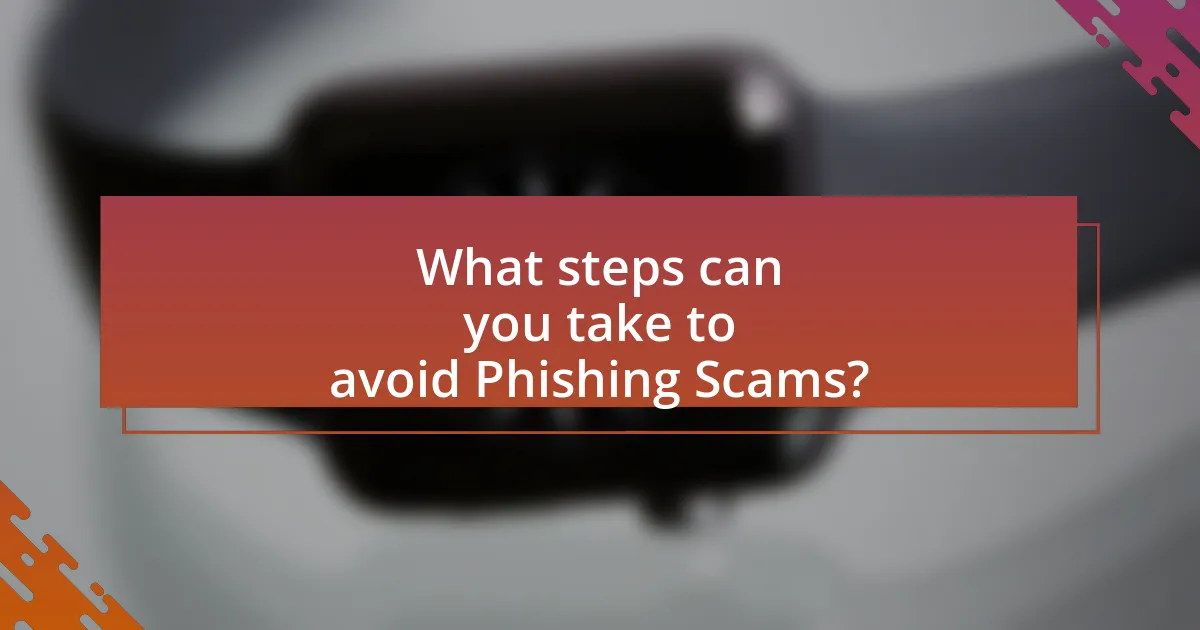
What steps can you take to avoid Phishing Scams?
To avoid phishing scams, individuals should implement several key strategies. First, always verify the sender’s email address before clicking on any links or downloading attachments, as phishing emails often use addresses that closely resemble legitimate ones. Second, utilize security software that includes phishing protection features, which can help identify and block malicious sites. Third, be cautious of unsolicited communications requesting personal information; legitimate organizations typically do not ask for sensitive data via email. Fourth, enable two-factor authentication on accounts whenever possible, adding an extra layer of security. Lastly, educate yourself and others about the latest phishing tactics, as awareness is crucial in recognizing potential threats. These steps are supported by data indicating that informed users are significantly less likely to fall victim to phishing attempts.
How can you protect yourself from Phishing attacks?
To protect yourself from phishing attacks, you should verify the authenticity of emails and messages before clicking on any links or providing personal information. This involves checking the sender’s email address for discrepancies, looking for spelling errors in the message, and confirming requests for sensitive information through official channels. According to the Anti-Phishing Working Group, in 2021, over 1.5 million phishing sites were reported, highlighting the prevalence of such attacks. Implementing multi-factor authentication on accounts adds an extra layer of security, making it harder for attackers to gain unauthorized access even if they obtain your credentials.
What best practices should you follow when handling emails?
To effectively handle emails and avoid phishing scams, always verify the sender’s email address before taking any action. This practice is crucial because many phishing attempts use addresses that closely resemble legitimate ones. Additionally, avoid clicking on links or downloading attachments from unknown or suspicious sources, as these can lead to malware infections or data breaches. According to the Anti-Phishing Working Group, 75% of phishing emails contain malicious links, highlighting the importance of cautious behavior. Furthermore, utilize email filtering tools to identify and block potential phishing attempts, which can significantly reduce the risk of falling victim to such scams. Regularly updating passwords and enabling two-factor authentication adds an extra layer of security, making unauthorized access more difficult.
How can you secure your personal information online?
To secure your personal information online, utilize strong, unique passwords for each account and enable two-factor authentication whenever possible. Strong passwords should be at least 12 characters long, combining letters, numbers, and symbols, which significantly reduces the risk of unauthorized access. According to a study by the National Institute of Standards and Technology, using two-factor authentication can block 99.9% of automated attacks, making it a critical step in protecting sensitive data. Additionally, regularly updating software and being cautious of suspicious emails or links can further safeguard your personal information from phishing scams.
What should you do if you encounter a Phishing Scam?
If you encounter a phishing scam, immediately cease any interaction with the suspicious message or website. This includes not clicking on links, not downloading attachments, and not providing any personal information. Report the phishing attempt to your email provider or the relevant platform, as they can take action to prevent further scams. Additionally, if you have already provided sensitive information, change your passwords and monitor your accounts for any unauthorized activity. According to the Federal Trade Commission, reporting phishing scams helps protect others from falling victim to similar attacks.
How can you report Phishing attempts effectively?
To report phishing attempts effectively, you should forward the phishing email or message to the appropriate authorities, such as the Anti-Phishing Working Group at [email protected] or your email provider’s abuse address. This action helps in tracking and mitigating phishing threats. Additionally, you can report the incident to the Federal Trade Commission (FTC) at reportfraud.ftc.gov, which collects information about scams and can take action against fraudulent activities. Reporting to these organizations is crucial as it contributes to broader efforts in combating phishing and protecting others from similar threats.
What steps should you take if you fall victim to a Phishing Scam?
If you fall victim to a phishing scam, immediately change your passwords for any affected accounts. This action helps secure your information and prevents unauthorized access. Next, enable two-factor authentication on those accounts to add an extra layer of security. Additionally, report the phishing incident to your email provider and any relevant financial institutions to mitigate potential damage. Monitoring your accounts for unusual activity is crucial, as it allows for early detection of any fraudulent transactions. According to the Federal Trade Commission, timely reporting can significantly reduce the risk of identity theft.
What are the best practices for staying safe online?
To stay safe online, individuals should implement strong password practices, utilize two-factor authentication, and be cautious of suspicious emails and links. Strong passwords should be unique, complex, and changed regularly to reduce the risk of unauthorized access. Two-factor authentication adds an extra layer of security by requiring a second form of verification, making it harder for attackers to gain access even if they have the password. Additionally, being vigilant about phishing scams involves recognizing signs such as poor grammar, unfamiliar sender addresses, and urgent requests for personal information, which are common tactics used by scammers. According to the Anti-Phishing Working Group, phishing attacks increased by 220% in 2020, highlighting the importance of these safety practices.
How can regular training help individuals and organizations?
Regular training enhances the ability of individuals and organizations to recognize and avoid phishing scams. By providing ongoing education about the latest phishing techniques and tactics, individuals become more adept at identifying suspicious emails and links, thereby reducing the likelihood of falling victim to scams. Research indicates that organizations with regular cybersecurity training experience a 70% reduction in successful phishing attacks, as employees are better equipped to recognize red flags and respond appropriately. This proactive approach not only protects sensitive information but also fosters a culture of security awareness within the organization.
What resources are available for learning about Phishing Scams?
Resources available for learning about phishing scams include government websites, cybersecurity organizations, and educational platforms. The Federal Trade Commission (FTC) provides comprehensive guides on recognizing and reporting phishing scams. Additionally, the Anti-Phishing Working Group (APWG) offers resources and research on phishing trends and prevention strategies. Online courses from platforms like Coursera and Udemy also cover phishing awareness and cybersecurity best practices. These resources are validated by their authoritative nature and the expertise of the organizations involved in cybersecurity education and awareness.
